Meeting Other Dogs – fearful aggression
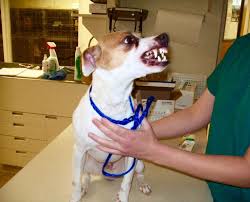 Meeting other dogs. Your dog is continually talking to you and his canine friends, but are you listening? Most dog owners know when their dog is fearful, it is obvious. Head down, crouched body, ears back and tail between the legs. This is how they often react when going to the vets! Fearful dogs at the vet often have no escape, so their only option is to fight and the weapon of choice… teeth! The majority of the time, a dog will give fair warning saying, “if you don’t stop, I will bite you and here are my teeth!”
Meeting other dogs. Your dog is continually talking to you and his canine friends, but are you listening? Most dog owners know when their dog is fearful, it is obvious. Head down, crouched body, ears back and tail between the legs. This is how they often react when going to the vets! Fearful dogs at the vet often have no escape, so their only option is to fight and the weapon of choice… teeth! The majority of the time, a dog will give fair warning saying, “if you don’t stop, I will bite you and here are my teeth!”
A fearful dog
But there is much more to communication in the canine world and it is well worth learning the language! For instance, if a dog is in a fearful or anxious state of mind, he has options if he is uncomfortable with the situation. He can flee, he can stand his ground and fight or he can avoid. The chosen option will surely determine how the dog’s body language will be displayed.
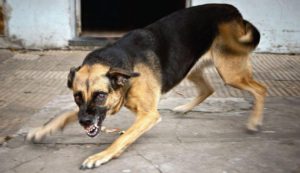 Fearful aggression
Fearful aggression
Most dogs who are cornered, will use the option to show aggression, albeit fearful aggression. It may be enough to deter a dog about to attack if he sees his quarry is fearful but willing to fight if necessary.
So probably a cornered fearful dog will display ears back, head and body low, with growling and snarling, tail low, pupils dilated. But it will still be seen by the prospective attacker, as an aggressive stance. If the fearful dog sees an escape route, he will take it. The attacker may give him that chance, to avoid getting bitten. In the wild, an injured animal is at a distinct disadvantage, so self preservation is of prime importance.
A fearful dog may want to make friends
A friendly dog may really want to get to know a dominant dog and do his best to curry favour with him. Strong friends and allies are important in a pack. Respect and lack of aggression will be shown by the submissive dog crouching down and making himself look small and unthreatening. He will display licking of lips, turn over or lie sideways. He may urinate, his ears will be back and he may display teeth in a ‘submissive smile’, perhaps chattering teeth.
ears will be back and he may display teeth in a ‘submissive smile’, perhaps chattering teeth.
A fight is not likely
The dominant dog knows what this stance means and is not likely to attack the submissive dog. He knows he is saying “Ok, I know you’re the boss” or “I’m really friendly” or even “can I be your friend”. After this display, the most likely outcome will be a playing session and both dogs will invariably be the best of friends from then on. This little brown dog is showing a typical example of this scenario.
A code of conduct?
Have dogs got a ‘code of conduct’ for each situation? I suspect so. If the code isn’t broken, then peace abounds. If you step out of line with the code, then you’re likely to be chastised. This could explain the different submissive behaviours for each situation. It may all depend on the sequence of events at the time. It is thought that those dogs without tails are at a disadvantage with their language skills. The tail is so important to relay how they are feeling to other dogs. Without this function tail-less dogs may be misunderstood which could lead to a aggression. Another good reason not to dock a tail!
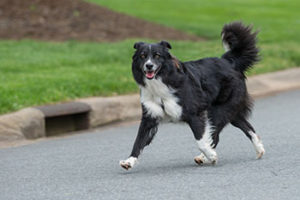 How to retreat from a dog
How to retreat from a dog
So what if you come across a dog that looks a little threatening. Here’s what to do. First of all, don’t run. This will likely elicit chase behaviour from the dog. Ignore the dog and definitely don’t make eye contact. Look to the side or somewhere in the distance. Don’t make any sudden moves and always stay calm. Stand tall and confident and don’t show any fear. Don’t make any noise or try and talk to the dog. Saying “Good doggie” just makes you look weak. Do not walk towards the dog, rather turn slowly away to the side without turning your back, ignoring him and slowly walking away. They can feel your energy so let your energy be strong, calm and assertive. Don’t forget, dogs can pick up your emotions, so a good calm energy will always be the best tactic.
What if you have a dog with you?
If you have a dog with you, don’t tighten up the lead, this will only signal to your dog that you’re worried. Most problems with dogs being unfriendly on the lead are due to the owner’s anxiety. Exhibiting tension by shortening the lead, holding the dog tight, or worse picking the dog up. Picking up your dog is an anxious move on 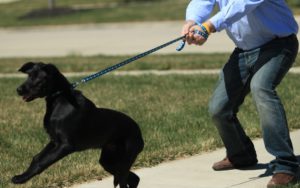 your part. It tells him you’re worried about the situation. This then causes anxiety in the dog and in the end it becomes a habit whereby the dog is always tense when out on a walk. Don’t look for trouble, keep a positive attitude and you may find that it is only rarely that you will have a problem with another dog.
your part. It tells him you’re worried about the situation. This then causes anxiety in the dog and in the end it becomes a habit whereby the dog is always tense when out on a walk. Don’t look for trouble, keep a positive attitude and you may find that it is only rarely that you will have a problem with another dog.
If your dog is loose
If your dog is loose, then as you turn and walk away, he will likely follow you, especially if he is well socialised. A socialised dog knows the ‘rules of engagement’ and will know by the body language of the aggressive dog that he’s best given a wide berth. If your dog is not well socialised and doesn’t know ‘the rules’ it’s best you keep him on the lead. Socialise him by meeting as many dogs as you can. Ask a fellow dog owner if you can walk with them for a while. Stop and speak to other dog owners so the dogs can get acquainted. Always keep a loose lead and if you’re in a secure area, perhaps the other owner will be happy for the dogs to get to know each other off lead and have a run around and play.
If your dog is well socialised…
If your dog is well socialised, he will have learnt, by the experience of meeting other dogs, what and what not to do when meeting another dog. He will assess the body language and work out if the dog is friendly, fearful, playful etc. At the same time, he will probably already know if the dog is male or female, or if it’s young or old. If it’s a bitch, he will know if she is in season or about to come into season.
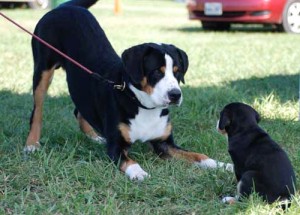
The approach must be polite
Once he has assessed that the dog is friendly, he will approach from the side, (if he is polite), not from the front. (Looking into the eyes of an unknown dog is classed as aggressive behaviour.) He will slowly check out his or her backend to memorise their individual scent. This is their way of saying ‘ how do you do’ and he will expect to be sniffed as well. He will also recognise the dog the next time they meet, by their smell. Remember, a canines prime sense is their sense of smell.
After the introductions, one or both of the dogs may instigate play by doing the playbow. They will then dash about having a whale of a time and you can enjoy their exuberance. This Bernese Mountain dog is obviously playful but a little on the large size for this pup. He has his ears back and he’s humped back shows he is a little pensive.

Dogs is not my strength; therefore this is the type of reading that gives me knowledge and educates me . I never grew up with dogs; on the contrary, I ran away from them because my mom did. Its true what they say; kids learn from their parents. Lol. However, I have learned about their aggression towards other dogs and at least have a mild idea about it.
Thank you for your comment Linda and I’m pleased you’ve taking the information on board, despite not having a dog. You never know, you may get one in the future, they are wonderful animals to live with, as long as you can understand each other!
I know that body language very well. Every time when I take my Shiro to the vet once he sees the front door he refuses to step in. However, if the vet is a pretty lady he will just follow her, lol. (Shiro is a husky, very hyper and short attention span) Thank you for sharing the tips on what to do if Shiro and I meet a scary dog. I will not pull him close from now on, but it is hard I do not want him to get bitten too.
I guess it is depends on a situation in what to be but it is good to know how to handle.
Cheers!
Hi there Nuttanee. Yes, body language is very important, in fact humans display much body language. We can learn a lot about a person’s mood just by looking at their stance and their facial expression. Dogs are the same but dogs cannot lie. Their body language is set by their DNA and cannot be expressed other than truthfully. They cannot control it. How great that would be if humans were as honest!
Hello there,thanks for this awesome article I know it would be of great help to the public as it has been of help to me.i really love dogs but I never knew wats behind that aggression that comes when they see other dogs…I really like how you explain the information in the code of conduct part of this article this info would really help me thank once more.
Thanks for your input Feji ben. Perhaps, as your really like dogs, you may have one in the future. They are amazing animals. They don’t lie, they are faithful to their family and they are always happy to see you. They are first class at knowing exactly how you are feeling and will be there to comfort you and make you smile.